Sutton Place
Minneapolis
Sutton Place may not have been Minneapolis’s first gay bar, but it was probably the most prominent. It was established in 1966 when it was still against the law to be a homosexual.
114 N. 7th STREET
The first location was in the Produce State Bank Building, across the street from First Avenue. The transfer of the liquor license showed that the license belonged to Evelyn H. Sutton. Jones said that “The bar had originally been Johnnie’s Lounge, then Sutton’s Lounge; Lockley’s crowd is calling it Sutton Place.” (My emphasis; some people remember it being called merely “Sutton’s.”)
I found a reference to a singer named Gloria Elwood singing at the Sutton Lounge in November 1952, but no address. There were no hits for Johnnie’s Lounge.
Another source called it “a quiet neighborhood bar in the Sumner/Glenwood area of North Minneapolis. It was an unpretentious establishment owned by a heterosexual married couple, Harold and Elizabeth Sutton.” I didn’t note the source and this doesn’t appear to be true.
“NEW PLACE TO CAMP”
Will Jones’s column of January 3, 1966, described the genesis of Sutton Place. It was purchased by “part-time TV personality, full-time hairdresser, and long-time Nicollet Av. character” Gordon Locksley and a group of “a group of Nicollet Av.-oriented partners.”
They opened it on New Year’s Eve, 1965, “after making a pass at redecorating the place by pasting up a lot of old movie posters with campy titles like ‘I Married a Queen’ and ‘Girls on Probation,’” said Locksley. “Nothing pretentious. It’s just a small, gay, side-street bar like you find in most of the the big cities.”
It was described as “Instant hitsville.”
“You never saw such a switch,” said Locksley. “Thursday night I went in, and there were a few couples sitting around. Friday night, the bar was filled with men, standing room only, and not a woman in sight. One couple did come in, and they seemed to enjoy watching the customers, but otherwise it’s been all boys.”
GORDON LOCKSLEY
The information below is a combination of information from three obituaries.
Gordon Allen Locksley was a hairdresser, private art dealer, collector of contemporary art, and bon vivant.
FAMILY
Locksley was born in Chicago on August 27, 1930, to William and Sheila Locksley (Lukowitz).
His grandparents, Isadore and Ella Lukowitz, came from Poland, emigrating before World War II. He was very close to his grandparents and his many aunts and uncles. His love for hearty, crusty breads came as the result of spending hours as a child at his grandparents’ bakery, which provided Chicago residents with their famous onion rye bread. He always told stories about his family, some rather humorous and always with love. Until he passed away, Gordon Locksley was the oldest member of the Lukowitz family.
His father worked in pharmaceutical sales for Max Factor and instilled a love of fragrances and their histories in his young son. His father listened to operas every weekend on the radio and Gordon learned how to appreciate and value great performances from his father, who won several telephone call-in contests. Gordon later developed a passion for Broadway musicals.
He was very close to his mother, who was a housewife. She and her sisters baked and canned vegetables together. Gordon learned his love of cooking from her and his aunts, especially his aunt Freda. Many of his friends have heard him tell stories and quotes from his aunt Freda. In fact, his family was filled with wonderful, caring members who helped Gordon become the man he became. Surrounded by his mother and aunts, Gordon was tutored in the art of cooking and acquired a passion for fine dining and entertaining, which lasted throughout his life.
As a teenager, he worked as an usher and in the cloak rooms of many of the theaters of Chicago which had live performances by famous people. Locksley fondly remembered meeting many who came through Chicago, most notably Sophie Tucker. He met and became friends with Jimmy Epenstein, who was a famous interior designer in Chicago. Mr. Epenstein took him to his first French restaurant where Mr. Locksley accidentally ordered scrambled eggs. Mr. Epenstein ordered the same. Later in life Mr. Locksley learned and spoke French and Italian fluently but always told the story of Mr. Epenstein with great fondness.
MOVING ON
Locksley moved to Columbus, Ohio for a brief time, and arrived in Minneapolis on a bus in a snowstorm wearing an opera cape. Never one to sit still, he checked into the YMCA and began working various jobs.
GEORGE SHEA
In 1954 he met George Shea who was an associate professor in Japanese language and literature at the University of Minnesota. In an era where it was literally illegal to be homosexual, Locksley and Shea were openly gay to the point where it was in the newspaper. Case in point: in an article about a break-in dated August 23, 1963, the account read that “Locksley and Shea were sleeping in an upstairs bedroom when the front door bell rang.”
RED CARPET
Locksley and Shea started the Red Carpet Beauty Salon and Red Carpet Beauty College at 925 Nicollet Ave., eventually locating it downtown on Seventh Avenue. Locksley styled hair for a living and on the weekends flew to national hair conventions for Revlon, demonstrating haircuts up on the turning stage for the attending hair stylists.
ART
Locksley later wanted to become an antiques dealer, but a friend, Jan Van der Mark, chief curator at the Walker Art Museum, encouraged him to look at contemporary art, which was just starting on the East Coast. He started selling posters out of the Red Carpet Salon walls to customers for $25.
LOCKSLEY SHEA GALLERY
The Locksley Shea Gallery began as a private gallery and became one of the leading contemporary art galleries in Minneapolis. It was located in his home on Mt. Curve Drive, which was where he and Shea lived and which they shared with the Colombian Consulate. Dayton’s 12 Gallery, headed by Felice Wender, was its main competitor. Miss Wender later became a very close friend of Locksley’s. The Locksley Shea Gallery was famous in the 1960s and ‘70s for its opening night parties with Minneapolis/St. Paul Society and contemporary artists all partying together. Artists such as Christo, Andy Warhol, Donald Judd, Brice Marden, Ellsworth Kelly and Robert Rauschenberg all came for the opening night parties of their exhibitions.
THE NIGHT OF THE WRAPPED NUDES
On December 15, 1967, Locksley invited 150 or so guests to a party to honor the artist Christo, whose specialty was to wrap things. In this case he wrapped two nude models in cellophane and tied them with rope. The seven-piece band the Perspectives played on the grand stairway of the main hall. Locksley said the party took four months to put together. From that night on, any reference to Locksley included a reminder of this epic party. (Minneapolis Tribune, December 17, 1967)
PARTY CENTRAL
Andy Warhol was the guest at a party on February 14, 1968; coverage mostly consisted of what the guests were wearing. He returned for a party on September 17, 1975.
The photo below is from a different party in 1969, attended by the beautiful people of Minneapolis. I’m guessing it’s our host, Mr. Locksley, in the silk pajamas, Hugh Hefner style.
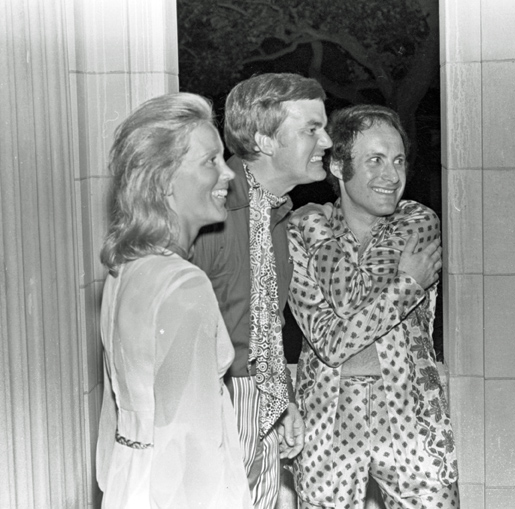
LOCAL CELEBRITY
Locksley was a frequent guest on a local television program and participated often as host of a Minneapolis radio talk show. His knowledge and sense of humor attracted very large viewing and listening audiences.
Locksley hosted several auctions and fundraising events on public television in Minneapolis and St. Paul. He raised more money for the local public television station than any other host in the 1970s. In 1974, right after a historic snowstorm, Locksley sold a Chuck Close painting to a famous London collector over the telephone.
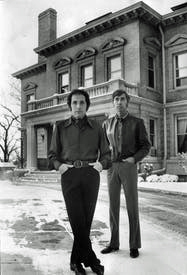
LEAVING MINNESOTA
- In 1976 there was a downturn in the art market, and Gordon and George Shea decided to leave Minneapolis for Rome, never to permanently return. He was quoted as saying that “Minneapolis was like one big Kiwanis Club,” and that “I’ve always wanted to live in a world capital.” They sold the house at 1300 Mount Curve to Antioch College. They also sold the Red Carpet and Sutton Place.
- They next moved to Cannes, France and then to Paris.
- In 1994 they returned to the United States and settled in Palm Springs, in a Quincy Jones designed estate, which was featured in the movie “Oceans Eleven.”
- In 1998, Locksley met Wayne Boeck and they moved to Fort Lauderdale, Florida. They lived in a highrise on the beach and married in November 2013 when same-sex marriages became legal in the United States.
FORT LAUDERDALE
Locksley was very active with the Museum of Art Fort Lauderdale, loaning contemporary works of art for a private collector exhibition, “With You I Want to Live,” in 2010. He had also loaned works from his collection to the Minneapolis Institute of the Arts.
DEATH
Locksley passed away quietly in Fort Lauderdale on February 1, 2014, after a brief illness, at age 83. He is remembered for his keen wit and wry sense of humor, his thoughtful generosity and devotion to friends, family and the art world. He is survived by his spouse, Wayne Boeck, and long time partner George Shea. His wishes were that he not have a memorial service and that his ashes and those of a favorite pet’s be spread on the mountainside above Palm Springs, California. He felt that this was an appropriate ending for a life well-lived.
MEANWHILE, BACK AT SUTTON PLACE…
LIQUOR PERMIT TO BE REVIEWED
An article in the Minneapolis Star dated May 25, 1966, revealed that the bar was under tight scrutiny, with several complaints lodged against it by police to the City Council Licenses Committee. Those complaints included:
- beer had been given away free
- “suggestive language” is used
- “conduct of the patrons” is improper
- the bar is “suggestive of homosexuality”
- more than 90 percent of the dancing is “men dancing with men”
On May 8, the Morals Squad checked the bar, and found:
- men dancing with men
- men holding hands
- evidence of a beer lottery
- a 19-year-old woman drinking beer
As a result of the beer lottery and underage drinking parts of the Morals Squad report, the License Committee recommended a 15-day license suspension on June 8, 1966. This was approved by the City Council on June 10.
WHAT IS INDECENT?
The city attorney’s office was asked by the City Council Licenses Committee to furnish guidelines to the police as to what constitutes unlawful public behavior by homosexuals. “Eugene Wilson, head of the Police Morals Squad, said men had been observed in the bar dancing together, holding and and kissing, but that no arrests had been made for indecent behavior. He said it is difficult to determine how flagrant such conduct need be to justify an arrest. What we might consider immoral may not be illegal.” He was also quoted as saying that although homosexual acts are illegal even in private, his staff “has better things to do.”
Assistant City Attorney Dabe Shama said “it probably isn’t indecent for men to dance together, but if he were a judge he would most certainly consider it indecent if they held hands, kissed or made suggestive movements.’”
Two other bars known to attract homosexuals have also been under surveillance but that no violations have been observed.. One alderman stated “I don’t know either where to draw the line between morality and immorality. None of these places are houses of worship.” Wilson said that “although homosexual acts are illegal even in private … ‘We couldn’t care less what one’s sexual philosophy is.’ Wilson said his squad makes about three or four arrests of homosexuals a month, mostly men dressed in women’s clothes in violation of a state law against concealing identity.” (Minneapolis Tribune, June 9, 1966)
The article in the Minneapolis Star on June 10 reporting the suspension indicated that there were two other gay bars in town.
In August 1974, it was reported that that the Sutton Place bar had expanded into space formerly occupied by a Chinese cafe and was now serving the best bargain lunch Downtown.
Facebook memories are that this first location was dark and small.
The earliest we find this address is June 1977, although April 1976 is probably closer to to the date of the move. One commentator on Facebook described the building as the old Litton microwave factory. Click the link above to see the many other venues in this spot before and after Sutton Place.
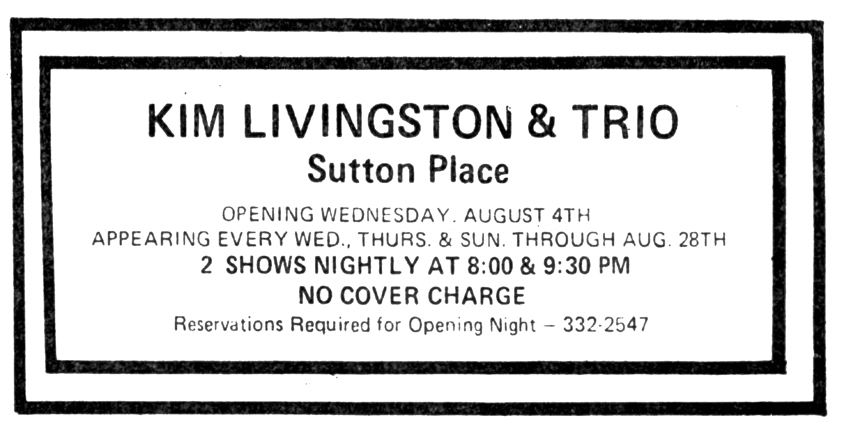
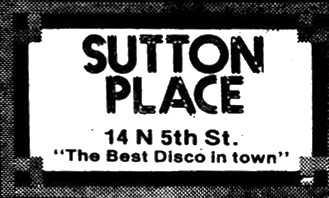
THE PESIS FAMILY
From at least April 1976, the owner of Sutton Place was Ernie H. Pesis. Ernie had owned the State Bar at 205 Nicollet, in Skid Row, from at least 1950 to 1954. It was demolished in 1961.
During the 1977 Minneapolis Mayoral campaign, Ernie was accused of asking his employees and some customers to make campaign contributions to Albert Hofstede, and Pesis would reimburse them with funds from the bar. State law and a city ordinance prohibit the use of corporate funds for campaign contributions.
Ernie’s son Ron Pesis also owned clubs in Minneapolis.
- April 1976: Ron owned Othello on Hennepin Ave.
- August 1979: Ron owned the Saloon
- Ron owned the gay bathouse/sauna the Locker Room Baths. It was famously raided on December 1, 1979.
Facebook memories of the second location:
- Sutton Place was THE disco to be seen in. It was glam to the hilt and the music was amazing.
- Sutton Place was the Studio 54 of Minneapolis.
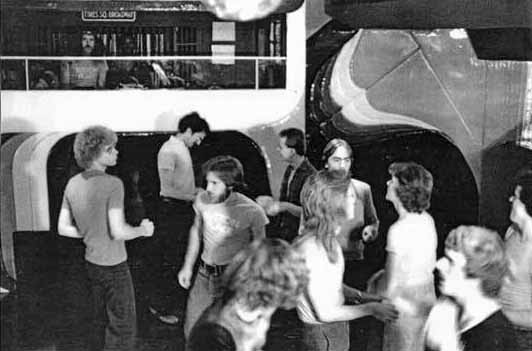
A disco guide in the Minneapolis Tribune dated November 4, 1977, described Sutton Place as:
Fast becoming a favorite of many black disco goers in the Twin Cities who have found there are no hassles at the door if you look of legal age. A mix of whites, blacks, gays, couples, and singles usually frequent this disco during the weekend. If you want to site down, you’d better come early. The light show is very good. People tend to dress up on the weekends. There also is a live band downstairs on weekends.
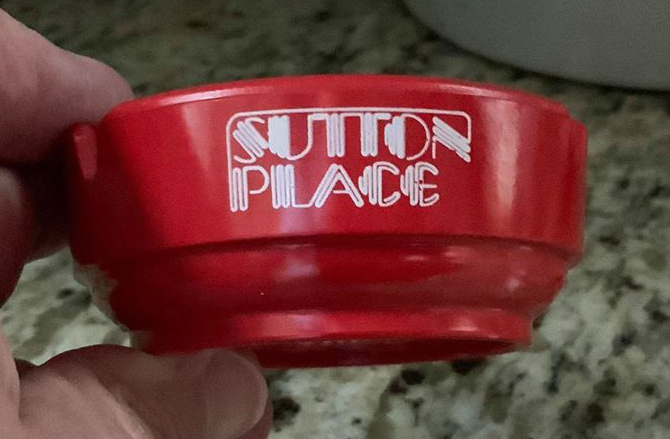
At the end of December 1977 the Club had been “revamped,” and the Suicide Commandos were performing at the New Year’s Eve party.
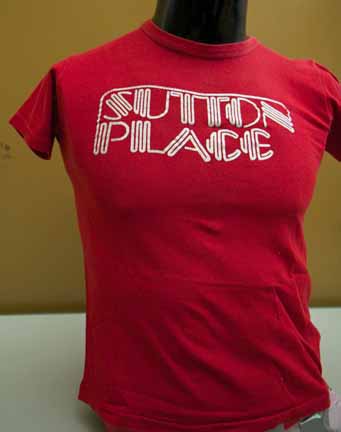
SUTTON PLACE OPENS AGAIN
An article in the Minneapolis Star dated February 24, 1978, catches us up on what’s been happening at Sutton Place.
In the past year or so, it went from a gay bar to a straight bar to an empty bar.
NEW OWNERS
New owners Charlie Senkler and Richard Giffin took over on January 1, 1978. They were aiming to attract upper income chic gays, to the point where straight couples were treated poorly. Star reporter Joe Logan and a female reporter “experienced a variety of tactics” to discourage them from future visits. A request to strengthen a weak drink was refused. They were accused of calling one of the waiters “a queer.” Another mixed couple next to them was told they had to order drinks or leave their seats. They were on the verge of being asked to leave by the owners until they identified themselves as reporters.
Logan described the layout of the newly-redesigned bar:
The two-story bar and disco has had no major structural changes. The downstairs area now is called the Palm Court, a bar and sitting room particular for gays, in a small, adjoining room is a dance floor with mirrored walls and music piped in from the disco on the second floor.
True to its name, the Palm Court has an abundance of plants, in addition to wicker and chrome furniture, bleacher seating and bars on both sides of the room. On the entryway walls are photos of scantily clad gay couples embracing. Also downstairs is a separate room with a bar.
Upstairs, in a larger, L-shaped room, is a disco featuring a stainless steel dance floor, five overhead mirror balls, tracers and strobes. Along the walls are three levels of bleacher seats and two more bars. Plans also call for audio-visual recording systems that will film dancers for playback later.
In a 1979 article, Karin Winegar reported that former Sutton’s lost its gay clientele by exploiting it with inflated prices and alienated straights by being rude to women who arrived with men. State records showed that three complaints were filed against Sutton Place from 1976 to 1978: one refusal to hire and two harassments of patrons. (Minneapolis Star, January 26, 1979)
ANOTHER NAME CHANGE
In September 1979 the name of the club was changed to the Fox Trap.
SHORT HISTORY OF LGBT LAWS IN MINNESOTA
Wikipedia:
Lesbian, gay, bisexual, and transgender (LGBT) persons in Minnesota have the same rights and responsibilities as non-LGBT people. Minnesota became the first state to outlaw both sexual orientation and gender identity-based discrimination in 1993, protecting LGBT people from discrimination in the fields of employment, housing and public accommodations. Minnesota is frequently referred to as one of the United States’ most LGBT-friendly states.
In 1849, the Minnesota Territory was given Wisconsin’s laws, including a ban on heterosexual and homosexual sodomy, which was defined by the common law. When Minnesota drafted its own criminal code, it kept this prohibition. In 1921, it expanded the definition of sodomy to include fellatio as well as anal intercourse. Beyond the criminal laws, vagrancy laws banned anyone from soliciting for “immoral purposes.”
In 1939, a wave of child molestation cases in St. Paul led to the enactment of a psychopathic offender law, which included LGBT people alongside rapists and child molesters. Though justified by the need to protect children and others from sexual abuse, those convicted of homosexuality constituted the major part of those imprisoned under it.
In 1967, the penalty for sodomy was reduced from a felony to a misdemeanor, punishable by up to one year in jail and/or a fine of $1,000.
In 1972, Jack Baker filed a lawsuit against Gerald R. Nelson after being denied a marriage license. The case resulted in the Minnesota Supreme Court ruling that Minnesota law limited marriage to opposite-sex couples and doing so did not violate the State Constitution or the United States Constitution. Although Baker subsequently appealed to the U.S. Supreme Court, his appeal was dismissed with a one sentence ruling.
An attempt to repeal the sodomy law failed in the Minnesota House of Representatives in 1973 by a vote of 69-46 with 19 abstentions.
In State v. Blom (1984), the Minnesota Supreme Court ruled that the criminal ban on sodomy also applied to the act of cunnilingus. A few years later in State v. Gray, the Court rejected the argument that privacy rights applied to sodomy involving prostitution. However, the court did recognize that the State Constitution protected privacy rights, although it stopped short of stating whether or not private, adult, consensual and non-commercial sodomy was covered under the State Constitution’s right to privacy.
In 1989, Minnesota laws were expanded to cover hate crimes on the basis of a person’s sexual orientation.
In 1992, Governor Carlson signed an executive order that prohibited discrimination on the basis of sexual orientation in state employment.
In 1993, sexual orientation was expanded to include the category of gender identity.] The law provides additional penalties for a crime committed based on the victim(s)’ sexual orientation or gender identity, alongside other categories such as race, religion or sex.
In 1993, Minnesota amended its statutes to prohibit discrimination on the basis of a person’s sexual orientation and/or gender identity in housing, insurance, goods and services, contracts, health benefits, hospital visitation rights, and employment.
The 1993 Minnesota Human Rights Act uses the following definition with regards to the phrase “sexual orientation:” “Sexual orientation” means having or being perceived as having an emotional, physical, or sexual attachment to another person without regard to the sex of that person or having or being perceived as having an orientation for such attachment, or having or being perceived as having a self-image or identity not traditionally associated with one’s biological maleness or femaleness. “Sexual orientation” does not include a physical or sexual attachment to children by an adult. The law does not apply to religious organizations, youth groups and certain small businesses.
The 1993 addition of sexual orientation to the Minnesota Human Rights Act also included the insertion of the following quote, part of which is still in force as of 2020:
363A.27 Construction Of Law.
Nothing in this chapter shall be construed to:
(1) mean the state of Minnesota condones homosexuality or bisexuality or any equivalent lifestyle;
(2) authorize or permit the promotion of homosexuality or bisexuality in education institutions or require the teaching in education institutions of homosexuality or bisexuality as an acceptable lifestyle;
(3) authorize or permit the use of numerical goals or quotas, or other types of affirmative action programs, with respect to homosexuality or bisexuality in the administration or enforcement of the provisions of this chapter; or
(4) authorize the recognition of or the right of marriage between persons of the same sex.
No bill has been introduced to repeal this law as of yet.
In Doe et al. v. Ventura et al. (2001), Minneapolis Judge Delilah Pierce ruled that the sodomy law violated the State Constitution when dealing with private, adult, consensual and non-commercial sodomy. The ruling was later certified as being a class action lawsuit and the State did not appeal, thus voiding the law in terms of private, consensual, non-commercial acts of sodomy by consenting adults. No bill has been introduced to repeal Minnesota’s sodomy law.
On November 6, 2012, Minnesota voters by a margin of 51.5 Percent to 47.5 Percent with 1 Percent abstention defeated a proposed amendment to the State Constitution that would have banned same-sex marriage in Minnesota.
On February 28, 2013, a bill was introduced in the Minnesota Legislature to legalize same-sex marriage in the state. On May 9, it passed the House of Representatives by 75-59 votes. On May 13, 2013, the Senate passed the bill by a vote of 37-30. Governor Mark Dayton signed the bill into law on May 14; same-sex marriage became legal and recognized in the state on August 1, 2013.
Though legislation outlawing same-sex sexual activity remains on the books, it has not been enforced since 2001 when the state Supreme Court ruled it unconstitutional.


